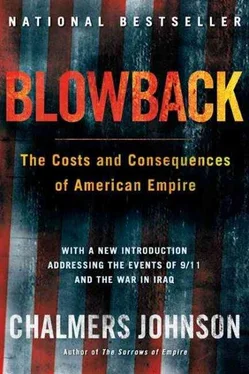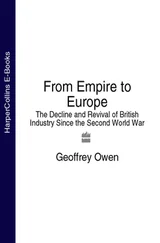Chalmers Johnson - Blowback, Second Edition - The Costs and Consequences of American Empire
Здесь есть возможность читать онлайн «Chalmers Johnson - Blowback, Second Edition - The Costs and Consequences of American Empire» весь текст электронной книги совершенно бесплатно (целиком полную версию без сокращений). В некоторых случаях можно слушать аудио, скачать через торрент в формате fb2 и присутствует краткое содержание. Год выпуска: 0101, ISBN: 0101, Издательство: Macmillan, Жанр: Старинная литература, на английском языке. Описание произведения, (предисловие) а так же отзывы посетителей доступны на портале библиотеки ЛибКат.
- Название:Blowback, Second Edition: The Costs and Consequences of American Empire
- Автор:
- Издательство:Macmillan
- Жанр:
- Год:0101
- ISBN:9780805075595
- Рейтинг книги:5 / 5. Голосов: 1
-
Избранное:Добавить в избранное
- Отзывы:
-
Ваша оценка:
- 100
- 1
- 2
- 3
- 4
- 5
Blowback, Second Edition: The Costs and Consequences of American Empire: краткое содержание, описание и аннотация
Предлагаем к чтению аннотацию, описание, краткое содержание или предисловие (зависит от того, что написал сам автор книги «Blowback, Second Edition: The Costs and Consequences of American Empire»). Если вы не нашли необходимую информацию о книге — напишите в комментариях, мы постараемся отыскать её.
Blowback, Second Edition: The Costs and Consequences of American Empire — читать онлайн бесплатно полную книгу (весь текст) целиком
Ниже представлен текст книги, разбитый по страницам. Система сохранения места последней прочитанной страницы, позволяет с удобством читать онлайн бесплатно книгу «Blowback, Second Edition: The Costs and Consequences of American Empire», без необходимости каждый раз заново искать на чём Вы остановились. Поставьте закладку, и сможете в любой момент перейти на страницу, на которой закончили чтение.
Интервал:
Закладка:
The American response, never expressly articulated but based on the total mobilization of the American people for the Cold War by President John F. Kennedy and other leaders, was twofold. First, we would do everything in our considerable power to turn Japan into a capitalist alternative to mainland China, a model and a showcase of what Asians might expect if they threw in their lot with the Americans instead of the Communists. Second, academic economics as taught in most American universities was subtly transformed into a fighting ideology of the “West.” From each of these transformations would come fateful consequences for the American empire after its competition with the Soviet Union ended. Because most Americans never understood either policy to be a strategy for pursuing the Cold War, they took both Japan’s achievements and the wealth of the West to be evidence of an ineluctable destiny that made the United States a singularly appropriate model for the rest of the world. Any doubts raised about these propositions were seen as undermining the pretensions of the American empire. Thus, what began as tactical responses to temporary, often illusory or misleadingly interpreted Soviet “advantages” ended up as ideological articles of faith for the “sole superpower” of the post–Cold War world.
From approximately 1950 to 1975, the United States treated Japan as a beloved ward, indulging its every economic need and proudly patronizing it as a star capitalist pupil. The United States sponsored Japan’s entry into many international institutions, like the United Nations and the Organization for Economic Cooperation and Development, well before a post–World War II global consensus in favor of Japan had developed. It also transferred crucial technologies to the Japanese on virtually concessionary terms and opened its markets to Japanese products while tolerating Japan’s protection of its own domestic market. It even supported the Japanese side in all claims by individual American firms that they had been damaged by Japanese competitors. In addition, the United States allowed Japan to retain an artificially undervalued currency in order to give its exports a price advantage for well over a decade longer than it did any of the rebuilt European economies.
We proclaimed Japan a democracy and a model of what free markets could achieve while simultaneously helping to rig both its economic and political systems. We used the CIA to finance the ruling party and engaged in all manner of dirty tricks to divide and discredit domestic socialists. 1In this process there was much self-deception. For far too long America’s leading officials insisted that Japan could never be an economic competitor of the United States’. President Eisenhower’s secretary of state John Foster Dulles was, for example, convinced that while the Japanese might be able to sell shirts, pajamas, “and perhaps cocktail napkins” to the American market, little else was possible for them. 2Americans did not wake up to Japan’s competitive challenge until their steel, consumer electronics, robotics, automotive, camera, and semiconductor industries were virtually extinct or fighting for their lives.
After the “security treaty riots” of 1960, when a Japanese mass movement tried to prevent the signing of a treaty that would perpetuate the basing of American troops in Japan and Okinawa, the United States moved its campaign to portray Japan as a model democracy into high gear. It appointed as ambassador the well-known Harvard historian of Japan Edwin O. Reischauer, who was married to a Japanese woman from a distinguished political family. His job was to repair the damage to the image of Japanese-American amity caused by the 1960 riots, which to many Asians appeared to be a Japanese equivalent to the Budapest uprising of 1956. Reischauer was to “reopen a dialogue” with the alienated Japanese left while shoring up the conservative Liberal Democratic Party, its aging rightists from prewar and wartime governments now screened from public view while it emphasized economic growth over democracy.
Perhaps Reischauer’s most influential step was to endorse in his own extensive writings and speeches of the time a movement among American academic specialists to rewrite the history of modern Japan as a case study of successful “modernization.” So-called modernization theory flourished in the United States during the 1960s just as the Japanese economy “took off” (to use that famous term of the modernization theorists), achieving double-digit growth rates. This new approach to Japan traced the country’s course of development from the Meiji Restoration of 1868, which was Japan’s debut as a unified nation rather than a collection of feudal states. It contrasted Japan’s achievement of great-power status with the dependency and susceptibility to colonialism of the rest of Asia, particularly China. It stressed how the initial authoritarianism of the Meiji oligarchs evolved into a toleration of political parties during the 1920s, producing at least the possibility of parliamentary democracy. The theory drew attention to how the “liberal” 1920s, although ultimately destroyed by reaction and militarism after 1931, provided precedents for reform that many Japanese leaders seized upon when genuine democratization got under way during the American occupation.
Japan emerged from this stirring tale of political and economic development as an exemplary nation, the only country in Asia that avoided being colonized. The fact that it did so by joining the Western colonialists in victimizing the other countries of Asia was underemphasized in such accounts. Japan’s kuroi tanima , or “dark valley,” from 1931 to 1945, in which it warred with China and the United States, was explained away as due to a unique concatenation of international factors—the Great Depression, the closing of European and American colonies to Japanese exports, Japan’s fear of bolshevism, and American isolationism. What actually went on in the “dark valley,” from the rape of Nanking to the Bataan Death March, was incidental to the tale of economic growth and political consolidation and best forgotten, since Japan’s aggression was now understood to be but a temporary sidestep on a long march toward modernization. The emperor of Japan, who had reigned since 1926 and presided over much military aggression and brutality, emerged as a simple marine biologist and pacifist who had opposed the war from the beginning and had actually brought it to an end in 1945 through his own decisive action. It was said that he was a man of few words in view of the fact that from the end of the war to his death in 1989 he was never again allowed to utter many in public.
The American public, like its policy elites never very well informed about Japan to begin with, bought this rosy picture of that country as the chief bulwark against communism in Asia. John Dower and a few American academic specialists argued that modernization theory was incomplete and that Japan’s militarism had domestic roots every bit as deep as its commitment to modernity, but they were easily ignored. 3Japan was now entrenched in American consciousness as a full-fledged democratic ally with a system rooted in free-market capitalism and certain eventually to “converge” with the United States as a liberal, consumer-based state.
To be sure, there were occasional “misunderstandings” as one nation’s capitalists sought competitive advantage over the other. In dealing with such “unfortunate” developments, the task of diplomacy and the mission of the American embassy in Tokyo became not to champion American interests but to ameliorate the conflict itself, usually to Japan’s advantage. Nothing seriously wrong could come of such policies, it was argued, because, as modernization theory taught, the two societies were on the same developmental path toward common economic ends.
Читать дальшеИнтервал:
Закладка:
Похожие книги на «Blowback, Second Edition: The Costs and Consequences of American Empire»
Представляем Вашему вниманию похожие книги на «Blowback, Second Edition: The Costs and Consequences of American Empire» списком для выбора. Мы отобрали схожую по названию и смыслу литературу в надежде предоставить читателям больше вариантов отыскать новые, интересные, ещё непрочитанные произведения.
Обсуждение, отзывы о книге «Blowback, Second Edition: The Costs and Consequences of American Empire» и просто собственные мнения читателей. Оставьте ваши комментарии, напишите, что Вы думаете о произведении, его смысле или главных героях. Укажите что конкретно понравилось, а что нет, и почему Вы так считаете.










